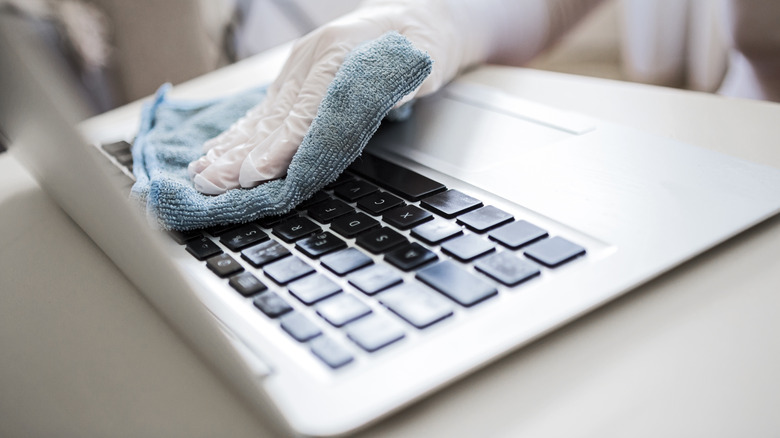How To Troubleshoot Your Laptop Keyboard Not Typing
A non-functioning (or improperly functioning) keyboard can be a sizable problem if you interact with your computer beyond just mouse-clicking. Writing, coding, gaming, composing, editing, or even simple social media interactions can suddenly become exponentially more difficult — or outright impossible.
In some ways, a malfunctioning keyboard on a laptop can be worse than having a similar issue with a desktop. In most instances, a laptop's keyboard is fused with the hardware, which makes something like a keyboard swap far more complicated.
Fortunately, typing troubles aren't always the result of hardware failures and won't necessarily require time-consuming or expensive solutions. Those can happen, certainly, and completely replacing the keyboard in a laptop can get expensive due to it being built into the hardware. This is why it's important to narrow down the possibilities by checking for the most simple (and easy to fix) causes first. Even the most basic troubleshooting methods might quickly set things right.
Simple reasons you can't type
There are a handful of simple explanations why your laptop's keyboard might not be typing, and they should only take a minute or two to check.
- Try moving the mouse cursor on the laptop's screen. If it doesn't move at all, the computer may be frozen, in which case you'll need to restart it.
- Some laptops have a Keyboard Lock function, which might have been turned on or left on accidentally. Exactly how this feature is turned on or off depends on the laptop model and manufacturer, so check the user manual or official website for instructions.
- If you're filling out a specific text field make sure it's selected before you start typing (the same goes for attempting to type in a specific app). Otherwise, your typing attempts might be interpreted as commands (or other kinds of inputs) on the desktop, inside a different app, or in another text field elsewhere on the page.
- If the problem seems to be with a specific web page or application, try refreshing the page or restarting the app, respectively.
- Restarting the laptop can sometimes also clear out whatever software or driver error might have been causing problems.
- On a Mac, click the Apple icon in the top-left corner of the screen and select Restart from the drop-down menu.
- In Windows 8, 10, or 11 open the Start menu and select Power, then click Restart. In Windows 7 or Vista, open the Start menu and click on the small arrow icon, then choose Restart.
If none of these methods get the keyboard typing again, it's time to try something a bit more involved.
Check your system for updates
Sometimes an errant keyboard is the result of outdated software, in which case you'll need to do a little digging.
- Check for version updates for the apps you're attempting to type in, as well as for your laptop's operating system.
- On a Mac, select the Apple icon in the top-left corner and select App Store, then click on the Updates option in the column on the left of the window. If any apps have available updates, start downloading them.
- To check for macOS updates, click the Apple icon in the top-left corner and select System Settings (or System Preferences in macOS 12 and older). Then click on General and select Software Updates.
- To update Windows apps, Click Start and type in "Microsoft Store" to open the Microsoft Store, then select Get Updates.
- In Windows 10, check for updates by clicking the Start button and selecting Settings, then choose Update & Security and select Windows Update.
- In Windows 11, click the Start button and select Settings, then choose Windows Update.
- Windows users can also check for keyboard driver updates via Device Manager. Open Device Manager and click on the arrow icon for Keyboards, then right-click the entry for the laptop's keyboard and choose Update Driver.
If everything is up to date but the problem persists, it's time to take a look at your settings.
Diving into settings
There's a chance that, somewhere along the way, your keyboard layout or settings got turned around and are confusing the system.
- In Windows 10, click on the keyboard icon in the bottom-right corner of the screen, then select an alternate keyboard layout from the list.
- If the icon doesn't appear on the taskbar, open Settings and select Personalization. Choose Taskbar, select Turn system icons on or off, then toggle on Input indicator.
- If you need to add a keyboard layout, open Settings and select Time & Language, then select Language and scroll down to Preferred languages.
- Select Options, choose Add a keyboard, then select the keyboard layout you want to add.
- To add a new keyboard layout in Windows 11, click Start and select Settings, then choose Time & Language.
- Select Language & Region, then click the Plus (+) icon to add a new layout.
- On a Mac, click the Apple icon in the top-right corner and select System Settings (or System Preferences in macOS 12 and older) then scroll down towards the bottom of the left-hand column and select Keyboard.
- Try adjusting settings like Key repeat rate or Delay until repeat to see if that makes a difference.
Most modern laptops also support external keyboards, so if changing your settings isn't helping and you have a spare keyboard, try plugging it in (or connecting via Bluetooth if it's wireless) and using that as a temporary solution.
When in doubt, clean
Barring outright hardware failure that necessitates a replacement or official repairs, your keyboard problems might be the result of too much dirt and debris buildup. In this case, cleaning the keyboard could be the solution you're looking for.
- Turn off the laptop and make sure it isn't plugged in.
- Using a small, soft brush (like an unused paintbrush or makeup brush), gently brush along the keys and spaces between them to pull up dust and other dirt — making sure to shake it out as the gunk accumulates, so you don't end up pushing more dirt back into the keyboard. Don't be afraid to get the bristles in and under the keys themselves, too.
- If you have a can of compressed air on hand, use that to blow along the surface of the keyboard in a "Z" pattern. Be sure to keep the nozzle at least an inch away from the keyboard (do not place it right up against the surface or into the crevices).
- Use a clean cloth — preferably microfiber — to wipe along the surface of the keyboard to pick up the remaining dirt and debris. You can also add a small amount of 70 percent Isopropyl Alcohol to the cloth to disinfect the keyboard or tackle stains and other unsightly spots.
It may also be possible to carefully pop off your laptop keyboard's keycaps individually with a small flathead screwdriver (or similar tool) at which point you can also clean behind the keycaps and deeper inside the keyboard itself. Be extremely careful when attempting this method, though, as not all keyboards are designed this way (which could lead to permanent damage if you try and force it).




